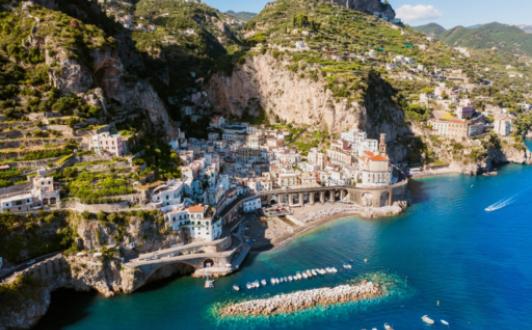Nestled along the picturesque Amalfi Coast in southern Italy, Amalfi Town is a charming seaside destination with a rich history dating back centuries. Once a powerful maritime republic, the town flourished as a center of trade and culture influenced by Arab traditions. Its stunning architecture, bustling trade routes, and economic prosperity were emblematic of its golden age. However, as the tides of time changed, Amalfi Town experienced a gradual decline from its former glory. Join us on a historical journey to uncover the rise and fall of this captivating town on the coast of Italy.

Amalfi Town's Rise to Maritime Power: A Timeline
By the 10th century, Amalfi had established itself as a major maritime republic, controlling a vast network of trade routes in the Mediterranean.
In 839, Amalfi played a crucial role in the defeat of the Saracens at the battle of Ostia, securing its position as a dominant force in the region. This victory allowed Amalfi to expand its trading activities and establish lucrative partnerships with other Mediterranean powers.
By the 11th century, Amalfi had become one of the wealthiest and most powerful cities in Europe, with a bustling port that welcomed ships from across the continent. Its fleet of merchant vessels dominated the seas, allowing Amalfi to thrive as a major trading hub.
During this period, Amalfi's maritime power reached its peak, as the city-state established colonies and trading outposts in North Africa, the Middle East, and even as far as Constantinople. The city's merchant ships carried a variety of goods, including silk, spices, and precious metals, making Amalfi a key player in the lucrative trade routes of the Mediterranean.
Despite facing various challenges and conflicts with neighboring powers, Amalfi's maritime power continued to grow throughout the 11th and 12th centuries. The city's strategic alliances with other maritime republics, such as Pisa and Genoa, helped to solidify its dominance in the region.
Despite its eventual decline in the late medieval period, Amalfi Town's rise to maritime power during the Middle Ages remains a testament to the city-state's resilience, ingenuity, and prowess on the seas.
The Influence of Arab Culture on Amalfi Town's Architecture
The influence of Arab culture on Amalfi Town's architecture can be seen in the intricate patterns and designs that adorn many buildings in the town. Arab architecture is known for its use of geometric shapes and patterns, which can be seen in the Islamic arches and intricate tile work that decorate many of Amalfi Town's buildings. In addition, the use of colorful tiles and mosaics is a common feature in Arab architecture, and can be found in many of the churches and palaces in Amalfi Town. This blending of Arab and European architectural styles gives Amalfi Town a unique and exotic charm that sets it apart from other towns along the Amalfi Coast.
Trade Routes and Economic Prosperity in Amalfi Town
The town's close proximity to major trade routes such as the Silk Road and the Spice Route enabled it to become a prosperous maritime republic.
Amalfi Town's economy thrived on the trade of luxury goods such as silk, spices, and ceramics from the East. The town's merchants and traders traveled far and wide, establishing relationships with both Eastern and Western markets. This cross-cultural exchange not only brought wealth to the town but also introduced new ideas and innovations in architecture, art, and technology.
The town's economic prosperity was further enhanced by its strong naval fleet, which protected its trade routes and ensured the safe passage of goods. The Amalfi Town's fleet also engaged in naval battles, expanding its influence and control over neighboring territories.
As Amalfi Town's wealth grew, so did its influence on the global stage. The town established trade agreements with major European powers and Asian kingdoms, solidifying its position as a key player in the medieval trade networks.
However, as the maritime republic's power and wealth began to decline in the late Middle Ages, Amalfi Town's trade routes and economic prosperity also suffered. The rise of competing city-states and the changing political landscape in the region eventually led to the town's downfall as a major trading power.
Despite its eventual decline, the legacy of Amalfi Town's trade routes and economic prosperity can still be seen in its rich historical architecture and cultural heritage, making it a fascinating destination for modern-day travelers seeking to explore the town's maritime past.
The Decline of Amalfi Town as a Maritime Republic
One of the main reasons for this decline was the rise of other maritime powers such as Genoa and Venice, which began to dominate trade routes and diminish Amalfi's control over the Mediterranean.
Additionally, the constant conflict and rivalry with other city-states in the region weakened Amalfi's position and strained its resources. The town's once-thriving economy began to decline as trade routes shifted and competition increased, leading to a decrease in maritime trade and prosperity.
Furthermore, internal strife and political instability within Amalfi Town also played a role in its decline as a maritime republic. Power struggles among the ruling elite and a lack of unity and cohesion weakened the town's ability to effectively govern and protect its interests.
As a result of these various factors, Amalfi Town gradually lost its status as a maritime power and was eventually overshadowed by other cities in the region. The decline of Amalfi as a maritime republic marked the end of its golden age and signaled a shift in power dynamics in the Mediterranean region.
